Habit is habit and not to be flung out of the window by any man, but coaxed downstairs a step at a time.
~Mark Twain
So….what exactly is this project?
No matter who you are, you are a person with habits. Some may be good, some may be harmless, and some may be so bad that they harm other areas of your life. For me, a lack of focus and a strong study routine have been my weak points. So weak in fact, that I decided to commit this entire project to improving in this area.
My ESEPSY 1259 coursehad us select a self-help book focused on an area of our lives we’d like to improve in. I did not have a clear goal in mind at first, but my book–Hack Your Habits—seemed general enough to help me in many areas, thus giving me time and wiggle room to figure out what I wanted this project to focus on.
While my class was getting started with selecting a book for this project, I was getting busy with midterms in my two most time-consuming courses: Physiology 3200 and Microbiology 4000. In my opinion, the course material is not difficult, rather there is a high volume of material. To do well, I needed to manage my time well, which meant getting the most out of my study time. I have never been great at focusing or getting work done in advance, so I decided to commit this project to forming habits that would help me focus and get more out of my study sessions.
Slightly “academic” section
I don’t wish to bore my fine readers during this small section, however, it is important that you understand exactly what I am writing about. The author of Hack Your Habits explains that habits stem from underlying issues that can be addressed with a strong system/routine of action. The book focuses heavily on identifying the true underlying causes of certain behaviors, and thus avoiding “Band-Aid solutions.”
The writer strongly disagrees with the idea that habits take 21 days to form. Her belief is that habit formation is a constant struggle and that any small progress towards your goal should be celebrated. It is much too difficult to completely change habits only because you decide to; it can be a slow process depending on how major the habit is. Personally, I found this encouraging. Even though I may not be able to quit a habit like biting my nails overnight, I can celebrate my small victories and improvements.
She also stresses the importance of not relying on willpower or motivation to fix a bad habit, as the underlying issue that caused the habit will remain. She is a strong believer in crafting a routine that eliminates or minimizes the chances of engaging in bad habits. She goes more in depth, including giving specific strategies, but these are the general type of ideas the book covers.
A full explanation of my project
With my circumstances and the teachings of the book in mind, I formed the project goal of studying for physiology for about 2 hours each day. I eventually changed it to working on school work an average of 3.5 hours per day with deep concentration in order to account for all my other classes. I am not always going to need to study 2 hours for physio each day, but I can generally find at least 3.5 hours of school work for myself, so this new goal was much more fitting and flexible.
To reach this goal, I implemented strategies from the book. First, I decided to use a cue system. The book explained the idea of having a reminder in your environment that spurs you into action to complete a task or get into a routine. I implemented this with google calendar. I set it up so that I would receive notification reminders on my phone to remind me to complete a task. Overall, I found the cue system to be unhelpful. My phone is often off during lectures or study sessions, so I usually don’t even see the notifications. Even when I do see the notifications, I don’t feel any more motivated. It is worth noting that I still enter reminders/notifications into google calendar, as I find it to be a great way to keep a to-do list. Below, I provide some pictures demonstrating how I use google calendar as a to-do list, as well as a picture showing a hypothetical reminder notification.
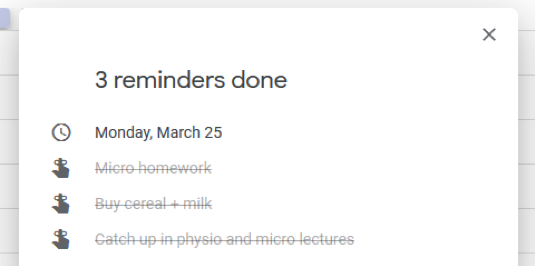




Next, I implemented the extra point decision strategy. The idea is that extra deterrents or steps can be added so that engaging in unwanted behavior becomes more of a hassle. To give an example, the book says the following on page 153:
“Say you are trying to stop yourself checking your phone when you are working. Introducing an extra decision point would be wrapping your phone into a few layers of paper, sellotaping it, and locking it in a drawer.”
Like the book example, I targeted my phone with this strategy. I did not go as far as what the book described, as I simply turned off my phone while studying. This extra step keeps me from doing a quick check of my phone every few minutes. This has worked very well for me (my phone is turned off as I type these words). Originally, I tracked the amount of time my phone was turned off via the “screen time” information on my iPhone. However, I found this very tedious to record. Instead, I decided to use the app “toogl” to record all the time I spend studying with my phone turned off. The toogl data below shows the large amount of time I spent away from my phone, as well as my improved times as I progressed (though I did not include spring break).

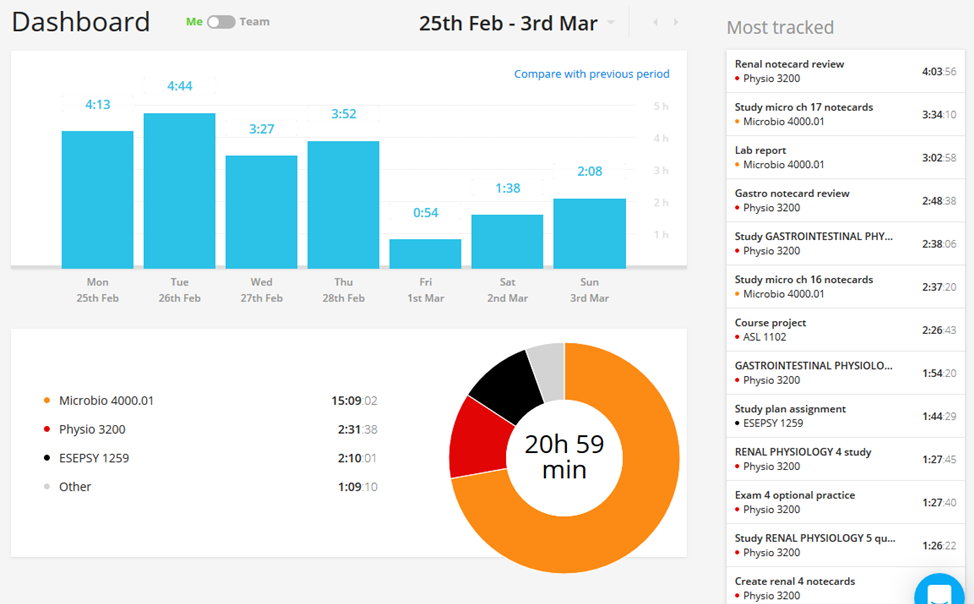

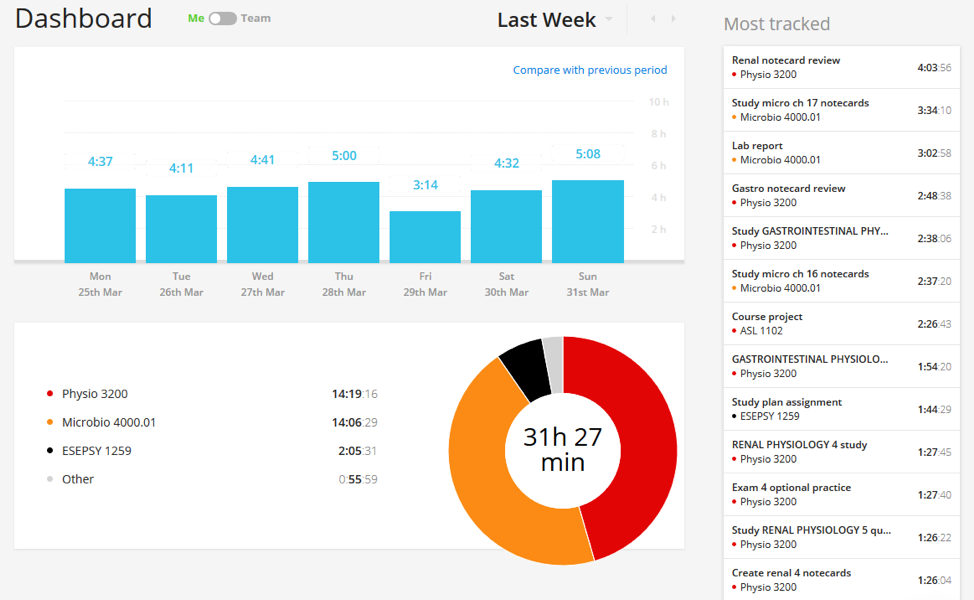
Lastly, I decided to use a reward in my routine to motivate me. The book discusses how personal reward can be used to motivate yourself. I decided to try a study routine where I study for blocks of about 45 minutes long with breaks of about 15 minutes long in-between. This type of strategy was also covered in our course readings, so I was extra intrigued by it. This strategy has been effective, as It gives me designated time to goof off and check my phone. I will no longer break my focus to do these things. As you see in my tracking data below, I don’t always stick to 45 minutes, but the idea of a break or two is a strong motivator. Specific examples were somewhat hard to find, as I rarely spend more than 2 straight hours studying. However, I spent a large amount of time studying on April 2nd, which perfectly shows the use of this strategy.
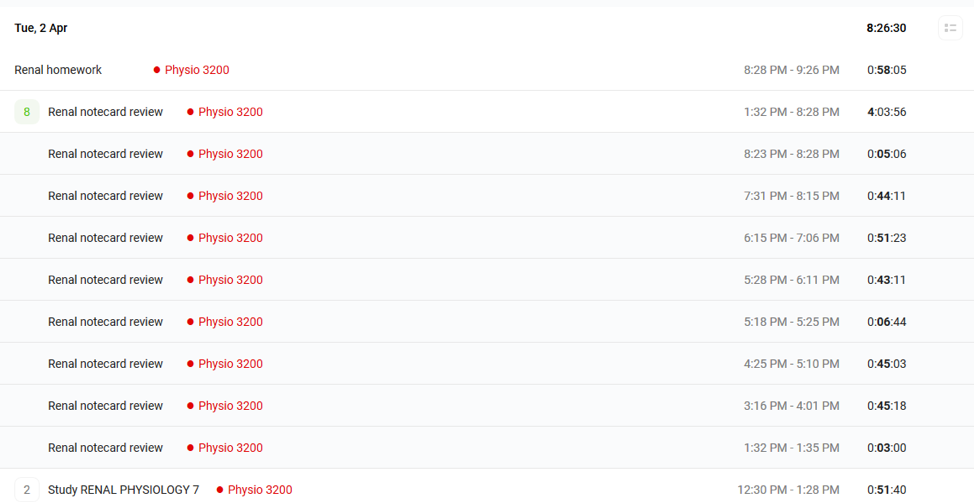
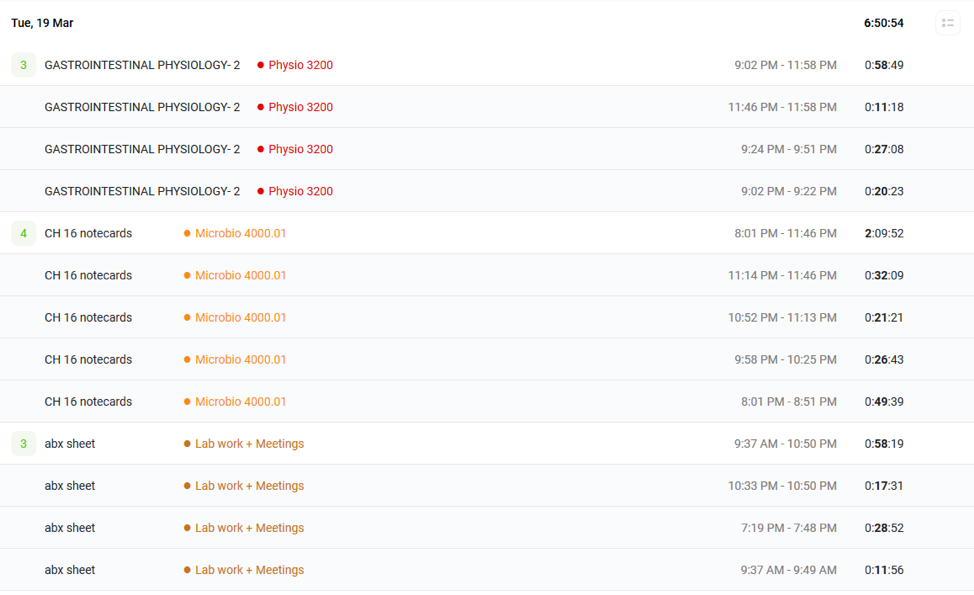
Over time, my tracking/strategies evolved into me tracking my study time whenever my phone is off. With the data that I collected on toogl, I formed the idea that about 3-4 hours of good studying per day will allow me to do well in my classes. So really, my strategies did not help me reach my goal, they helped me create a new, more practical goal for myself.
Conclusion and takeaways
Overall, I believe that I improved my study routine through this project. The biggest thing I learned is that sometimes you need to adjust your goals and plans to move forward and improve. My original tracking plan and goal just didn’t work out, but they led to a new daily goal that is serving me well. I’ll continue to avoid my phone and other small distractions while studying. Additionally, I will continue to track how I am spending my study time, as it can continue to give me insight into how I spend my time.
If I had to give advice to others, I’d say understand how much your phone and the internet can take away from your study time. It may take a few minutes of uninterrupted studying to get into a flow; checking your phone every few minutes prevents this from happening. Needless to say, this was another big takeaway for me.
Another big takeaway I’d like to share is that it’s important to understand yourself and what works for you. For me, my google calendar cue system failed, but I am sure there is a person out there that would gain a lot from it. Try your best to play to your strengths and build a system that caters to them. This very idea was a huge point of focus in Hack Your Habits. As I have demonstrated, this advice turned out to be very relevant during this project.
